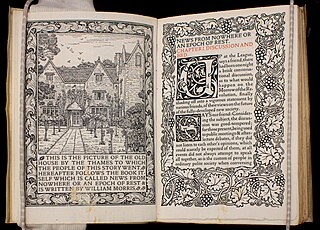Our website is made possible by displaying online advertisements to our visitors.
Please consider supporting us by disabling your ad blocker.
Kelmscott Press
 | |
| Industry | Printing |
|---|---|
| Founded | 1891 in Hammersmith |
| Founder | William Morris |
| Defunct | 1898 |
| Headquarters | |
The Kelmscott Press, founded by William Morris and Emery Walker, published 53 books in 66 volumes[1] between 1891 and 1898. Each book was designed and ornamented by Morris and printed by hand in limited editions of around 300. Many books were illustrated by Edward Burne-Jones.[2] Kelmscott Press books sought to replicate the style of 15th-century printing and were part of the Gothic revival movement.[3] Kelmscott Press started the contemporary fine press movement, which focuses on the craft and design of bookmaking, often using hand presses.[4] While their most famous books are richly decorated, most Kelmscott Press books did not have elaborate decoration, but were published simply.
Morris was interested in medieval book design, visiting the Bodleian Library often with Burne-Jones to examine illuminated manuscripts. He designed and published several books before founding Kelmscott Press. Book dealers and designers complained about the poor quality of books published on the new rotary printing presses; Morris agreed that their quality was poor. After attending a lecture by Emery Walker on book design, Morris was inspired to collaborate with him on a new font of type, and their collaboration led to the founding of the Kelmscott Press, named after Kelmscott Manor, Morris's home in Oxfordshire.

Walker enlarged photographs of fine typefaces for Morris to trace and take inspiration from. Morris then drew his new font design at the enlarged size, which Walker in turn reduced. All three of Morris's fonts were created this way. Morris loved the aesthetics of 15th-century books and modelled his margins and spacing after them. He put smaller spaces between words and lines to create a block of text, and had large outer margins where he put shoulder-notes. Some Kelmscott books were heavily decorated with woodblock designs created by Morris. To create the look of an uninterrupted block of text, Morris sometimes printed poetry as prose. Kelmscott Press's most famous book was its edition of the complete works of Chaucer. The Chaucer contains 87 wood engravings by Edward Burne-Jones and many designs and initials by Morris. The book is considered a masterpiece of the fine press medium.
The Press closed shortly after Morris's death, but has exerted a huge influence on book production throughout the world.[5][6]
- ^ "William Morris – Iceland and socialism". Encyclopedia Britannica.
- ^ Peterson 1991, p. 4.
- ^ Peterson 1991, p. 5.
- ^ Dowd, Douglas (1995). "Meditations on the C-word". Contemporary Impressions. 3 (7): 6–9.
- ^ Stansky (1983), p. 87.
- ^ Parry (1996), p. 41.
Previous Page Next Page


